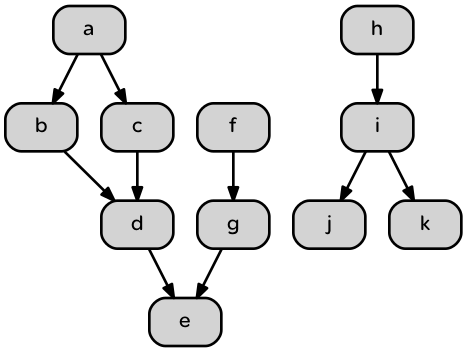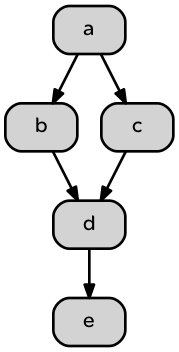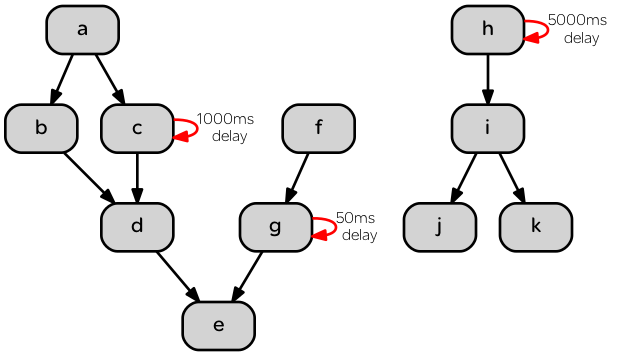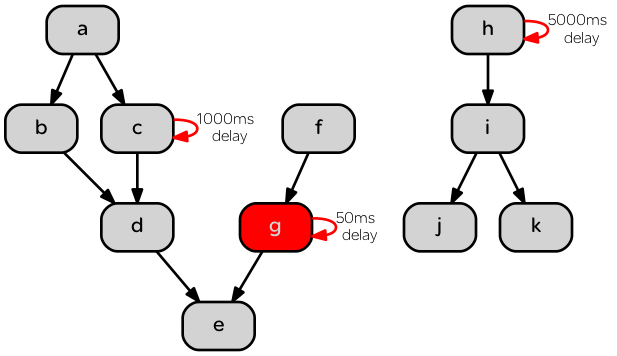Define and run the simplest possible Akka executor directed acyclic graph
As input the DAG takes a graph adjacency list and a payload for each executor:
| Node ID | List of Precursors | Payload command |
|---|---|---|
| a | (none - we start here) | println(a) |
| b | a | println(b) |
| c | a | println(c) |
| d | b,c | println(d) |
| e | d | println(e) |
The input configuration is a JSON data structure that reflects the above relationships.
[
{ "name" : "a", "precursors" : [], "payload" : {"cmd":"println(\"a\")"} },
{ "name" : "b", "precursors" : ["a"], "payload" : {"cmd":"println(\"b\")"} },
{ "name" : "c", "precursors" : ["a"], "payload" : {"cmd":"println(\"c\")"} },
{ "name" : "d", "precursors" : ["b","c"], "payload" : {"cmd":"println(\"d\")"} },
{ "name" : "e", "precursors" : ["d"], "payload" : {"cmd":"println(\"e\")"} }
]The execution follows the graph flow - a node only executes its payload when all its precursors have successfully completed.
##How to run
$ sbt
[info] Loading global plugins from /Users/v/.sbt/0.13/plugins
[info] Loading project definition from /Users/v/wa/akka-micro-dag/project
[info] Set current project to akka-micro-dag (in build file:/Users/v/wa/akka-micro-dag/)
> run dag.json
:will parse the json input file, construct the corresponding actor graph and execute it. Printing out payload strings.
##A more interesting execution graph

Here the DAG implementation has to know to kick off nodes a, f and h. The (h,i,j,k) sub-graph is independent. The user specifies the relationships like this:
[
{"id": "a","precursors": [], "payload": "exe a"},
{"id": "b","precursors": ["a"], "payload": "exe b"},
{"id": "c","precursors": ["a"], "payload": "exe c"},
{"id": "d","precursors": ["b","c"], "payload": "exe d"},
{"id": "e","precursors": ["d","g"], "payload": "exe e"},
{"id": "f","precursors": [], "payload": "exe f"},
{"id": "g","precursors": ["f"], "payload": "exe g"},
{"id": "h","precursors": [], "payload": "exe h"},
{"id": "i","precursors": ["h"], "payload": "exe i"},
{"id": "j","precursors": ["i"], "payload": "exe j"},
{"id": "k","precursors": ["i"], "payload": "exe k"}
]The run sequence looks like this (with all tasks taking roughly the same time to execute - a single println statement):
λ sbt
> run dag1.json
background log: info: exe a
background log: info: exe h
background log: info: exe f
background log: info: exe i
background log: info: exe g
background log: info: exe b
background log: info: exe c
background log: info: exe d
background log: info: exe j
background log: info: exe k
background log: info: exe e
background log: info: b reported complete - now total complete List(a, f, h, i, g, b, c, d, j, k, e)
background log: info: run completed
[success] Total time: 1 s, completed Jun 12, 2015 1:47:08 PM
>##With task delays simulated We introduce simulated delays for each node. The input specification changes to:
[
{"id": "a","precursors": [],"payload": "exe a"},
{"id": "b","precursors": ["a"],"payload": "exe b"},
{"id": "c","precursors": ["a"],"payload": "exe c","delay":1000},
{"id": "d","precursors": ["b","c"],"payload": "exe d"},
{"id": "e","precursors": ["d","g"],"payload": "exe e"},
{"id": "f","precursors": [],"payload": "exe f"},
{"id": "g","precursors": ["f"],"payload": "exe g","delay":50},
{"id": "h","precursors": [],"payload": "exe h"},
{"id": "i","precursors": ["h"],"payload": "exe i","delay":5000},
{"id": "j","precursors": ["i"],"payload": "exe j"},
{"id": "k","precursors": ["i"],"payload": "exe k"}
]Node c,g and i will take the specified time to complete their tasks (after being kicked off by their precursors):
The execution order changes to:
λ sbt
> run dag1delays.json
background log: info: exe f
background log: info: exe h
background log: info: exe a
background log: info: exe b
background log: info: exe g
background log: info: exe c
background log: info: exe d
background log: info: exe e
background log: info: exe i
background log: info: exe k
background log: info: exe j
[success] Total time: 6 s, completed Jun 12, 2015 10:08:34 PM
>##With forced failures By design the graph execution is aborted when any node fails at executing its task. The graph with a specified failure:
[
{"id": "a","precursors": [],"payload": "exe a"},
{"id": "b","precursors": ["a"],"payload": "exe b"},
{"id": "c","precursors": ["a"],"payload": "exe c","delay":1000},
{"id": "d","precursors": ["b","c"],"payload": "exe d"},
{"id": "e","precursors": ["d","g"],"payload": "exe e"},
{"id": "f","precursors": [],"payload": "exe f"},
{"id": "g","precursors": ["f"],"payload": "exe g","delay":50,"fail":true},
{"id": "h","precursors": [],"payload": "exe h"},
{"id": "i","precursors": ["h"],"payload": "exe i","delay":5000},
{"id": "j","precursors": ["i"],"payload": "exe j"},
{"id": "k","precursors": ["i"],"payload": "exe k"}
]λ sbt
> run dag1fails.json
background log: info: exe h
background log: info: exe a
background log: info: exe f
background log: info: exe b
background log: info: Fail at List(g)
background log: info: aborting the graph!
background log: info: run completed with List(a, f, h, b)
background log: info: exe i
background log: info: exe c
[success] Total time: 1 s, completed Jun 12, 2015 11:17:59 PM
>

